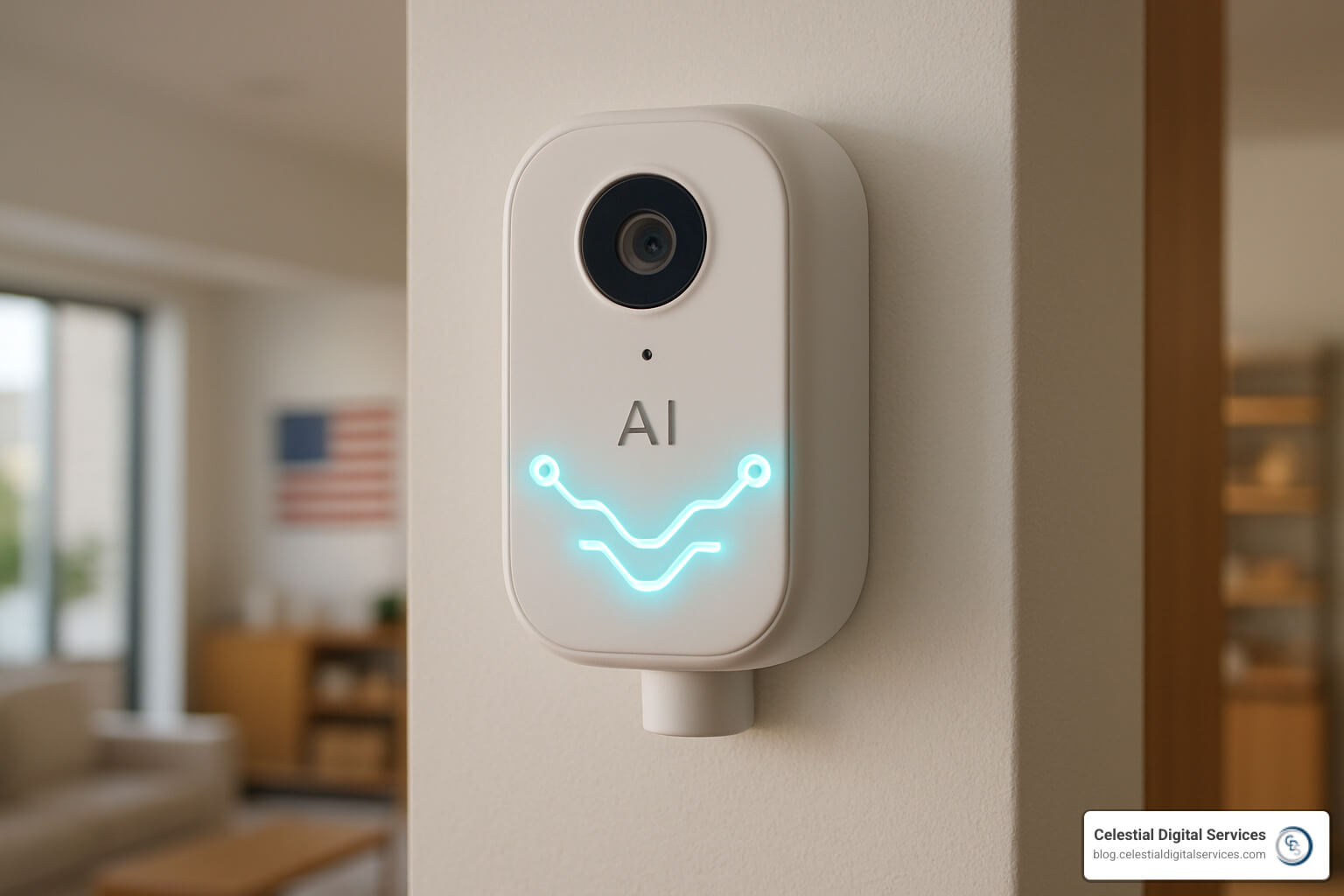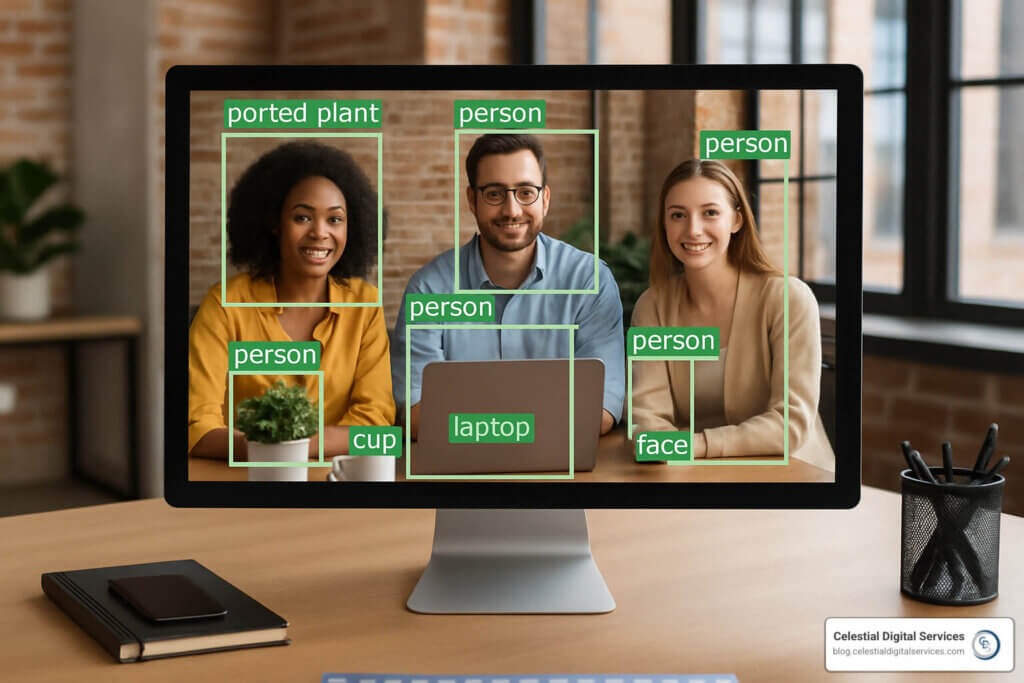AI Image Recognition: 7 Powerful Best Solutions for 2025
Why AI Image Recognition is Changing Business Operations
AI image recognition technology enables computers to identify, analyze, and classify objects, people, text, and scenes within digital images and videos. Here’s what you need to know:
Key AI Image Recognition Solutions:
– Cloud-based platforms – Scalable APIs from Google, Amazon, Microsoft for instant deployment
– Edge devices – Real-time processing with privacy protection and offline capabilities
– Open-source frameworks – TensorFlow, PyTorch for custom model development
– No-code SaaS tools – Drag-and-drop interfaces for non-technical users
The global image recognition market is exploding – projected to reach $86.32 billion by 2027 with a growth rate of 17.6% annually. This surge has created a 116% increase in job demand for computer vision engineers.
Unlike humans who process visual information subconsciously, machines must convert images into pixel data arrays and learn patterns through training on millions of labeled examples. What once seemed like science fiction is now accessible to small businesses through various platforms and tools.
Whether you’re looking to automate quality control, improve customer experience, or streamline operations, the right AI image recognition solution can transform how your business handles visual data.

Key terms for AI image recognition:
– AI-based customer insights
– AI-powered lead generation
– AI technology in marketing
How Does AI Image Recognition Work?
AI image recognition teaches computers to see like humans – except they learn from scratch. When you see a photo of your dog, you instantly recognize Rover. But computers see only thousands of colored pixels with red, green, and blue values between 0 and 255.
The magic happens when we transform these pixel arrays into meaningful labels through sophisticated algorithms.
Convolutional Neural Networks (CNNs) handle most modern image recognition. These networks work like your brain’s visual processing – they start by spotting simple features like edges, then gradually build up to recognize complex objects. A CNN might first detect curved lines, then combine those into circles, and eventually recognize wheels on a car.
Vision Transformers represent the newest breakthrough, borrowed from language processing. Instead of treating an image as one picture, they analyze small patches and how these patches relate to each other. These models often outperform traditional CNNs.
For simpler tasks, Support Vector Machines (SVMs) remain useful – like the reliable pickup truck of image recognition. They require less computational power and fewer training examples.
All these algorithms depend on quality training data. Data annotation – labeling images correctly – can make or break your system. Poor labeling introduces bias causing real-world mistakes.
Scientific research on medical diagnostics shows AI systems now detect certain diseases with accuracy rates exceeding human specialists.
Human vs. Machine Vision
Humans and machines “see” completely differently. Your eyes contain 120 million photoreceptors instantly sending signals to your brain. You can spot your friend’s face in a crowd or recognize your car in a parking lot without thinking.
Machines see the world as spreadsheets of numbers – no intuition, no past experiences, no “gut feelings.” A model must examine thousands of labeled cat photos before confidently identifying “that’s a cat.”
But machines have superpowers humans lack. They never get tired after reviewing thousands of images. They don’t have bad days or get distracted. They spot patterns so subtle human eyes would miss them.
While human radiologists might overlook early cancer signs after hundreds of scans, AI image recognition systems maintain perfect consistency whether processing the first or ten-thousandth image.
Training Pipeline
Building effective AI image recognition follows a step-by-step process. Data collection comes first – modern systems need thousands to millions of images per category. The IdenProf dataset contains 11,000 images across 10 categories, while cutting-edge models train on 11 million images.
Data preparation involves resizing images to standard dimensions, cleaning noise, and normalizing pixel values. Data augmentation creates new examples by rotating, flipping, and adjusting colors of existing images, helping models recognize objects from different angles and lighting.
Model training uses algorithms that gradually adjust internal settings based on mistakes. Over multiple training rounds, the model improves accuracy. Validation and testing check performance on unseen images using metrics like accuracy and precision.
Deployment transforms trained models into real-world applications – mobile apps or cloud APIs. Monitoring continues after deployment, watching performance as real-world data can drift from training examples.
For businesses ready to implement these capabilities, our AI-Based Customer Insights service helps steer this complex pipeline.
AI Image Recognition Solutions Roundup
Choosing the right AI image recognition solution can feel overwhelming. Think of it like choosing a car – you need to match specific needs with the right features and budget.
The landscape includes powerful cloud services, edge devices that work offline, open-source libraries for developers, and no-code platforms for point-and-click solutions.
Consider what matters most: lightning-fast responses for real-time applications, data privacy requirements, or cost concerns. Data privacy often drives the choice between cloud and edge solutions. Latency requirements determine network delay tolerance. Cost structures vary dramatically.

Cloud-Based AI Image Recognition Platforms
Cloud platforms offer supercomputer power without expensive hardware or data science teams. The beauty lies in scalability – start with few images daily and grow to millions seamlessly.
Pretrained APIs are game-changers. These models learned from millions of images and recognize thousands of objects immediately. Need product identification? There’s an API. Want text extraction? Another API handles it perfectly.
GPU acceleration processes images in milliseconds instead of hours. The pay-as-you-go pricing makes advanced AI accessible to all business sizes – you only pay for usage.
However, high-volume usage gets expensive, and you depend on internet connectivity. Some businesses worry about uploading sensitive images externally.
Scientific research on cloud scalability shows modern platforms maintain performance under extreme loads.
Edge & On-Device AI Image Recognition Kits
Edge computing brings AI image recognition directly to your camera, phone, or device – like having a mini data scientist in your hardware.
Real-time processing eliminates network delays. Security cameras instantly detect intruders, manufacturing equipment spots defects immediately, and mobile apps recognize objects without server waits.
Privacy protection is huge. Medical facilities analyze patient scans without sending data anywhere. Your sensitive images never leave your control.
Offline capabilities ensure systems work without internet – crucial for remote locations or unreliable connectivity.
The trade-off? Hardware constraints limit sophisticated models. Model quantization helps squeeze larger models into smaller devices, but performance compromises exist compared to cloud processing.
Open-Source Frameworks & SDKs for AI Image Recognition
Open-source frameworks offer unlimited flexibility but require technical expertise. TensorFlow dominates with comprehensive tools and massive community support. PyTorch takes a research-friendly approach for experimenting with cutting-edge techniques.
Keras simplifies complexity with user-friendly interfaces. Transfer learning lets you adapt pre-trained models for specific needs, saving months of development time.
Vision Transformers represent the latest breakthrough, often outperforming traditional approaches. Community support provides invaluable resources – someone has likely solved your problem and shared the solution.
Challenges include needing technical expertise, longer development timelines, and ongoing maintenance. But for organizations with right skills, open-source offers maximum flexibility and cost-effectiveness.
Our AI optimization services help businesses steer these frameworks efficiently.
No-Code / Low-Code AI Image Recognition SaaS
No-code platforms democratize AI image recognition through drag-and-drop interfaces – no programming required.
AutoML capabilities handle complex machine learning behind the scenes. Upload labeled images, and platforms automatically select model architecture, tune parameters, and train everything.
Data labeling interfaces make annotation almost enjoyable. Simply draw boxes around objects or click to categorize images. Analytics dashboards translate complex AI metrics into business insights through easy-to-understand charts.
Marketing teams can build product recognition systems, quality control managers can create defect detection tools – all without involving IT.
Limitations include less customization and potential vendor lock-in. But for most businesses, especially those starting with AI, no-code platforms offer the perfect balance of power and simplicity.
Choosing the Right Deployment: Cloud vs. Edge vs. API
Picking the right deployment strategy for AI image recognition can feel overwhelming, but it doesn’t have to be. Think of it like choosing between a restaurant, home cooking, or meal delivery – each works great in different situations.
The key is understanding what matters most for your specific business needs. Some companies need lightning-fast responses, others prioritize keeping data private, and many just want the most cost-effective solution that gets the job done.

Latency is your first big decision point. If your application needs to respond in the blink of an eye – think security cameras detecting intruders or quality control systems spotting defects on a production line – edge processing is usually your best bet. These systems can react in under 100 milliseconds because everything happens locally.
Cloud-based solutions add a bit of delay since your images need to travel to remote servers and back. For many applications like analyzing customer photos or processing inventory images, this extra second or two doesn’t matter much.
Bandwidth becomes a real headache when you’re dealing with high-resolution images or video streams. Imagine trying to send dozens of 4K video feeds to the cloud simultaneously – your internet connection would crawl to a halt. Edge devices handle this processing locally, keeping your network running smoothly.
Security and compliance requirements can make the choice for you. Healthcare facilities dealing with patient images, banks processing check deposits, or any business handling sensitive visual data often must keep everything on-premise. Cloud services, no matter how secure, simply aren’t an option when regulations demand complete data control.
Total cost of ownership tells a different story depending on your usage patterns. Cloud APIs feel almost free when you’re starting out – maybe a few dollars for thousands of image analyses. But those costs add up quickly with heavy usage. Edge devices flip this equation with higher upfront costs but minimal ongoing expenses.
Maintenance responsibilities separate the hands-on businesses from those preferring turnkey solutions. Cloud services handle everything automatically – updates, security patches, performance improvements all happen behind the scenes. Edge deployments put you in the driver’s seat, which means more control but also more work keeping everything running smoothly.
| Deployment Model | Latency | Privacy | Scalability | Maintenance | Best For |
|---|---|---|---|---|---|
| Cloud API | Medium | Low | High | Minimal | Variable workloads, rapid deployment |
| Edge Device | Low | High | Limited | High | Real-time processing, sensitive data |
| Hybrid | Variable | Medium | High | Medium | Flexible requirements, cost optimization |
Hybrid approaches offer the best of both worlds for businesses with complex needs. You might process critical security footage locally while sending less sensitive marketing images to the cloud for detailed analysis. This strategy provides maximum flexibility but requires more planning and technical expertise.
The reality is that most small businesses start with cloud APIs because they’re simple to implement and scale naturally with growth. As your needs become more specific or volumes increase, you can always migrate to edge processing or implement a hybrid solution.
Future Trends & Best Practices
The AI image recognition world moves fast, but the technology is getting smarter and more accessible daily, making it easier for small businesses to participate.
Self-supervised learning changes the game by teaching computers to understand images without humans labeling every picture. Models like MAE (Masked Autoencoders) show impressive results, meaning businesses won’t need massive labeled datasets.
Multimodal AI systems don’t just see images – they understand them with text, sounds, and other data. Imagine uploading a storefront photo and having AI describe what it sees, suggest improvements, or answer customer questions.
Generative augmentation tackles the biggest AI development headache – insufficient diverse training data. AI can now create realistic synthetic images to fill dataset gaps, particularly helpful for addressing bias issues.
The Segment Anything Model represents a versatility breakthrough. Unlike traditional systems needing specific training for each task, these models identify and outline any object in any image – like having a universal tool.

Explainable AI addresses the biggest business concern – understanding why AI makes certain decisions. Instead of mysterious black boxes, these systems explain their reasoning. This transparency becomes crucial for important business decisions and regulatory compliance.
When implementing AI image recognition, focus on dataset diversity to prevent mistakes and ensure systems work for all customers. A security camera trained only on daylight photos won’t perform well at night.
Continuous monitoring maintains AI performance over time. Setting up automated alerts when performance drops prevents customer complaints and lost opportunities.
Clear ethical guidelines protect business reputation and build customer trust. Transparency about data collection, respecting privacy, and ensuring fair treatment becomes a competitive advantage.
Planning for model updates keeps investments valuable long-term. Building flexibility into implementation strategy ensures you can leverage improvements without starting over.
These trends point toward a future where AI image recognition becomes as common as email or web browsers – more powerful while easier to use.
Our Benefits of AI in Business guide explores how these capabilities can transform operations across industries.
Frequently Asked Questions about AI Image Recognition
What accuracy can I expect in real-world conditions?
In perfect laboratory conditions, modern AI systems achieve accuracy rates above 95%. However, real-world results typically fall between 80-90% for most applications.
Lighting conditions significantly impact performance. Perfect training photos might not match dim warehouse lighting or outdoor cameras dealing with bright sunlight to nighttime conditions.
Image quality matters more than expected. Blurry smartphone photos, compressed images, and unusual angles can trip up sophisticated systems. If training data consists of professional photography but real-world images come from handheld devices, expect performance gaps.
Noise and environmental factors create additional problems. JPEG compression, transmission errors, and sensor limitations introduce visual “noise.” Weather conditions like rain or fog further complicate outdoor applications.
The diversity of training data directly impacts real-world performance. Models trained on wide varieties of conditions typically perform much better when deployed.
Industry benchmarks provide reference points. Medical imaging applications often achieve 90-95% accuracy for specific tasks, while general object recognition typically ranges from 75-85%.
How important is data labeling quality?
Data labeling quality often matters more than having the fanciest algorithm or powerful hardware. Poor labeling can completely undermine your project regardless of other investments.
If training labels contain 10% errors, your model can’t exceed 90% accuracy, even with perfect learning. Quality ground truth data sets the ceiling for entire system performance.
Consistency across labelers becomes crucial when multiple people annotate images. Different interpretations of “damaged product” or object boundaries create training confusion. Clear guidelines and quality checks maintain team consistency.
Modern annotation tools have become sophisticated. Platforms provide initial labels using pre-trained models, which human reviewers correct and refine. This significantly reduces manual effort while maintaining needed accuracy.
Active learning techniques make labeling budgets go further by identifying the most valuable images to annotate, highlighting examples that will most improve model performance.
Can small businesses afford AI image recognition?
Yes – AI image recognition has become surprisingly accessible, and you don’t need Fortune 500 budgets.
Open-source frameworks like TensorFlow and PyTorch provide free access to algorithms powering major tech companies. While requiring technical expertise, these tools eliminate licensing fees entirely.
Pay-per-use cloud APIs offer budget-friendly entry points. Instead of huge upfront costs, pay only for usage – typically $0.001 to $0.01 per image. Start with hundreds of images monthly and scale up.
Edge devices represent different cost models – higher upfront investment ($500-$5000) but no ongoing API fees. For businesses processing thousands of images regularly, this often becomes more economical while providing better privacy.
No-code platforms eliminate development costs through drag-and-drop interfaces. Monthly subscriptions typically range from $50-$500.
The real question isn’t whether you can afford AI image recognition – it’s whether you can afford not exploring it. Many small businesses find it pays for itself through operational efficiency improvements.
Conclusion
The AI image recognition landscape reveals technology that’s both exciting and surprisingly accessible. What once required PhD teams and million-dollar budgets now fits in your pocket or runs through simple API calls. With the market racing toward $86.32 billion by 2027, businesses embracing this technology early gain significant advantages.
Your smartphone already identifies objects, translates signs, and diagnoses plant diseases. That same power is available for business operations – inspecting products, organizing inventory, or creating smarter customer experiences.
Today’s AI image recognition solutions offer remarkable flexibility. Need something immediately? Cloud APIs provide pre-trained models working out of the box. Concerned about data privacy? Edge devices keep everything local. Want complete control? Open-source frameworks provide unlimited access. Prefer simple interfaces? No-code platforms make AI accessible to everyone.
What’s particularly exciting is the technology’s direction. Self-supervised learning will eliminate tedious image labeling. Multimodal AI will understand not just what’s in pictures, but the stories they tell. These advances are happening now in research labs and will reach your hands soon.
At Celestial Digital Services, we’ve seen how AI image recognition transforms small businesses. The restaurant that automated food quality checks. The retail store that implemented visual search and doubled online conversions. The manufacturer that caught defects before reaching customers. These aren’t Fortune 500 companies – they’re businesses like yours.
Success doesn’t come from having the most sophisticated technology. It comes from choosing the right solution for specific needs and implementing it thoughtfully. Whether that’s simple API integration or custom edge device deployment, the goal remains the same: making your business more efficient, competitive, and profitable.
Ready to find what AI image recognition can do for your business? Our team specializes in translating complex AI capabilities into practical solutions driving real results. We handle technical complexity so you can focus on running your business.
Let’s explore how our AI optimization services can help you harness visual AI power to stay ahead in today’s rapidly evolving digital landscape. The future of business is visual, intelligent, and surprisingly within reach.



